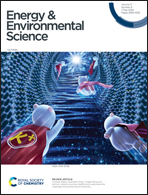Facets control charge separation during photoelectrochemical water oxidation with strontium titanate (SrTiO3) single crystals†
Abstract
The photocatalytic overall water splitting reaction provides a pathway to hydrogen fuel from sunlight. Photocatalysts must achieve the reaction without the application of an external bias, which requires an effective charge separation mechanism. Photolabeling studies and electrostatic simulations for the well-known CoOOH/Al:SrTiO3/Rh/Cr2O3 photocatalyst suggest that charge separation is driven by work function differences at the (100) and (110) facets of SrTiO3, which are electron and hole selective, respectively. Here we use hydrogen annealed SrTiO3−x single crystals to obtain the first quantitative assessment of the charge separation ability of the (100), or (110), or (111) facets during oxygen evolution. Under UV illumination (60 mW cm−2), the crystals exhibit variable water oxidation photocurrents (0.34, 0.82, 1.36 mA cm−2 at 1.23 V versus RHE) and photovoltage values of 1.40, 1.52 and 1.52 V for (100), (110), and (111) SrTiO3−x, respectively. A surface photovoltage increase in that same order (0.31 V < 0.57 V < 0.67 V) is confirmed independently with vibrating Kelvin probe surface photovoltage spectroscopy (VKP-SPV) under 375 nm (1.91 mW cm−2) illumination. Mott Schottky measurements in aqueous K3/4[Fe(CN)6] reveal facet-dependent flatband positions of −0.58, −0.71, and −0.74 V RHE for the (100), (110), and (111) crystals respectively. This confirms that the photoelectrochemical water oxidation performance of SrTiO3−x crystals is controlled by the work function of each facet, which determines the electron transfer barrier height of the respective solid–liquid junctions. After correcting for differences in electron donor concentrations, barriers are found to increase in the order (100) < (111) < (110) and differ by as much as 0.16 eV, similar to an earlier prediction. Overall, these results explain the charge separation mechanism in SrTiO3 photocatalysts and highlight the need for faceted semiconductor crystals as light absorbers in particle-based photocatalysts.



 Please wait while we load your content...
Please wait while we load your content...